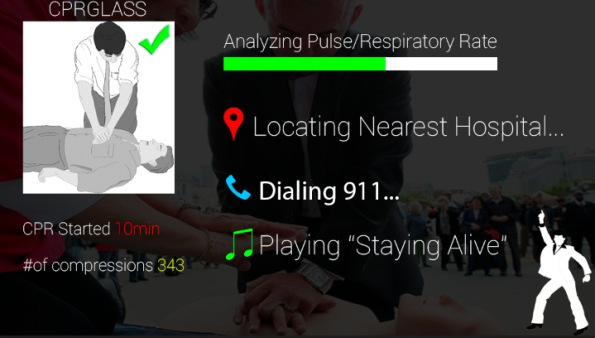What does the useful application for Google Glass look like?

According to the latest research published in the journal Resuscitation Urban , only one fifth of people (not professional doctors) are familiar with the basics of conducting emergency medical activities, in particular, with such a vital thing as artificial respiration ( in the original, Hands-Only CPR (Cardio Pulmonary Resuscitation) ) - Manual cardiopulmonary resuscitation).
Practicing cardiologist Christian Assad (probably a big fan of gadgets), together with developers Chris Vukin and Thomas Schwartz, created an application for Google Glass called CPRGlass that should greatly ease the task of those who have to face fainting and stopping heart without the presence of doctors and, thus, the need to conduct resuscitation on the spot.
The application works as follows.
')
If the owner of the glasses has witnessed fainting, then to launch the program, you should give the voice command " OK GLASS, CPRGLASS ", which will cause a demonstration on the display of the instructions for conducting ABC (Assess Airway Breathing and Circulation - assessment of the possibility of breathing and blood circulation) - according to the medical protocol carrying out resuscitation measures namely the absence of independent breathing and blood circulation (as well as consciousness), is a direct indication for CPR.
If it turns out that the unconscious person does not have a pulse (it is recommended to check the carotid artery, since it is very difficult to make a mistake there), then the glasses begin to act as follows:
- The melody of Staying Alive is turned on - the American Heart Association has created a video with the talking name Staying alive (you can see it here ), the musical rhythm of which corresponds to one hundred beats per minute - this is the frequency of pressing the patient’s chest during resuscitation as the most suitable for such events.
- Each movement of the arms (and the head, respectively) of the carer is estimated using the gyroscope built into the Glass, determining the adequacy of pressing the patient's chest.
- Similarly, time and number of clicks are tracked.
- Based on GPS (from a smartphone that is associated with Glass glasses), the location of the incident is determined and communicated via text message with the nearest hospital, equipped with defibrillators with information and a call is made soon - by calling 911.
At the moment, CPRGlass is still awaiting improvement based on the technology proposed by MIT, which allows to determine the presence of a pulse from a video image with high accuracy.
[ Source ]
Source: https://habr.com/ru/post/185974/
All Articles